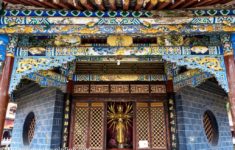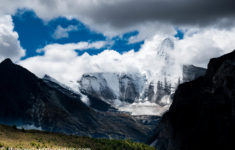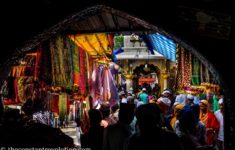UNESCO heritage site, the Old Town of Lijiang is the perfect place to take a relaxing walk, shop for souvenirs, and taste great food. But also to learn about the town cultural heritage and its ethnic group, the Naxi people.
The city, located in the North-West Yunnan, is really not that big, just over 1.2 mil. inhabitants, and everything worth visiting is normally reachable by foot. I spent one day and a half there, mostly a passage to my next destination.

It is indeed a very touristic place, both for Chinese and foreigners. So, not exactly my style. Yet, I must admit the Old Town is really cute to walk around, especially in the morning (8h to 10h) when there are much fewer people. You might let yourself get lost among the over 1,000 years old narrow streets, and take advantage for a couple of nice pics with empty streets. Walking at night is also quite suggestive, as the lights create a kind of traditional atmosphere.

The architecture of the Old Town absorbs aspects from Han, Bai, Tibetan and other ethnic styles, making it very charming. There are a couple of viewpoints worth reaching as well. In a clear weather, the Jade Dragon Snow Mountain can be seen in the background, with its summit perennially snow-capped. This is also the most iconic photo of Lijian.
Considered part of the Old Town, a visit to the Black Dragon Pool could be nice. However, it cost 80 Yuan (about 10€) to enter. I didn’t go. As a long-term traveller, spending 10 or 20 bucks every time I want to see something is just not possible. It happens often with temples as well. Sometimes, you are asked for an entrance fee to the Old Town as well. In such a case, just change direction and enter from another side, without hesitation.
CULTURAL HERITAGE
A small museum at the edge of the Old Town, close to the tourist information office, can be visited in about an hour. It’s free, and it provides much interesting information about the Old Town and the Naxi people, the ethnic group inhabiting the feet of the Himalayas in the north and south-west Yunnan.

Known as the middlemen along the Tea-horse Road, connecting Tibet’s capital Lhasa and India for trading purposes, Naxi people are notable for the integrity. They created the famous Dongba culture, with its own religion, ancient music, language and calligraphy, festivals, art, architecture, and customs. The Jade Dragon Snow Mountain is their holy mountain, which is the abode of San Duo, their protection God.
Holy waters and the three wells
The Old Town of Lijian is a well-organised system of bridges and canals. This is not a surprise as in the spiritual world of the Naxi water is considered the creator of life and origin of good fortune. Water is an important component of their lives, and it forms the core essence of their belief that nature and people are one.
They became indeed very skilled at managing their water resources, and they harnessed the city underground springs by building “Three-Eyed Wells” systems, still used nowadays. The top pool is used for drinking, the middle pool is used to wash vegetables, and the lower pool is used to wash clothes.

The Naxi hold in high esteem knowledge and education. Indeed, one of the most important sentences in their culture is “te en lu fan” which means “Commence your studies”.
Here is an extract from a Dongba classic: “the story of the combat between God and the Great Eagle:”
In an ancient, epoch-making era, the Sun and the Moon shone upon the Earth. They were born of different mothers but shared a common father, and they ruled over the Gods of Nature as well as mankind. As the Gods and the Humans began to encroach on one another, a dispute erupted between them. The Dongba Shiluo God mediated, and the two sides ended their disagreement and from then on lived together in harmony.
THE LIJIANG MAN
Lijiang was also one of the most important areas of ancient human activities in China. A large numbers of artefacts dating up to 50 thousand years have been unearthed in the area, as well as the fossilised skull of a late Paleolithic Homo Sapiens, the so-called “Lijiang man”. Also, the Jinsha River valley cave have revealed ancient paintings. The city has quite a big collections of many types of artefacts, including nearly three thousand old relics of Naxi Dongba culture.

Viva the transparency! There are affiliate links in this article. This means if you click on a link and end up buying (or booking) through those websites, I’ll get a small commission, at no extra cost to you. This helps me maintain the blog, and continue to provide (hopefully) useful travel information. I advertise only products I have tested and sites I use myself!






